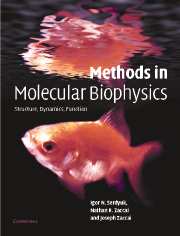Book contents
- Frontmatter
- Contents
- Foreword by D. M. Engelman
- Foreword by Pierre Joliot
- Preface
- Introduction: Molecular biophysics at the beginning of the twenty-first century: from ensemble measurements to single-molecule detection
- Part A Biological macromolecules and physical tools
- Part B Mass spectrometry
- Part C Thermodynamics
- Part D Hydrodynamics
- Chapter D1 Biological macromolecules as hydrodynamic particles
- Chapter D2 Fundamental theory
- Chapter D3 Macromolecular diffusion
- Chapter D4 Analytical ultracentrifugation
- Chapter D5 Electrophoresis
- Chapter D6 Electric birefringence
- Chapter D7 Flow birefringence
- Chapter D8 Fluorescence depolarisation
- Chapter D9 Viscosity
- Chapter D10 Dynamic light scattering
- Chapter D11 Fluorescence correlation spectroscopy
- Part E Optical spectroscopy
- Part F Optical microscopy
- Part G X-ray and neutron diffraction
- Part H Electron diffraction
- Part I Molecular dynamics
- Part J Nuclear magnetic resonance
- References
- Index of eminent scientists
- Subject Index
- References
Chapter D3 - Macromolecular diffusion
from Part D - Hydrodynamics
Published online by Cambridge University Press: 05 November 2012
- Frontmatter
- Contents
- Foreword by D. M. Engelman
- Foreword by Pierre Joliot
- Preface
- Introduction: Molecular biophysics at the beginning of the twenty-first century: from ensemble measurements to single-molecule detection
- Part A Biological macromolecules and physical tools
- Part B Mass spectrometry
- Part C Thermodynamics
- Part D Hydrodynamics
- Chapter D1 Biological macromolecules as hydrodynamic particles
- Chapter D2 Fundamental theory
- Chapter D3 Macromolecular diffusion
- Chapter D4 Analytical ultracentrifugation
- Chapter D5 Electrophoresis
- Chapter D6 Electric birefringence
- Chapter D7 Flow birefringence
- Chapter D8 Fluorescence depolarisation
- Chapter D9 Viscosity
- Chapter D10 Dynamic light scattering
- Chapter D11 Fluorescence correlation spectroscopy
- Part E Optical spectroscopy
- Part F Optical microscopy
- Part G X-ray and neutron diffraction
- Part H Electron diffraction
- Part I Molecular dynamics
- Part J Nuclear magnetic resonance
- References
- Index of eminent scientists
- Subject Index
- References
Summary
Historical review
1850
T. Graham observed that egg albumin diffuses much more slowly than common compounds such as salt or sugar. In 1861 he used dialysis to separate mixtures of slowly and rapidly diffusing solutes, and made quantitative measurements of diffusion on many substances. On the basis of this work he classified matter in terms of colloids and crystalloids.
1855
A. Fick, in the equations now known as his first and second laws, defined a diffusion coefficient (D) to describe the flow of a solute down its concentration gradient. J. Stefan (1879) and L. Boltzmann (1894) developed mathematical integral forms of the second law, opening the way for the experimental determination of diffusion coefficients by various methods.
1905–1906
A. Einstein, W. Sutherland and M. von Smoluchowski determined that steady-state solutions of Fick's equations have a direct analogy in heat flow along a temperature gradient, and established mathematical relations between diffusion and frictional coefficients in Brownian motion. In 1905, W. Sutherland used a value of D calculated by J. Stefan from data collected by T. Graham, to obtain a molecular weight of 33000 for egg albumin (the true value is about 45000).
1926
L. Mandelshtam recognised that the translational diffusion coefficient of macromolecules could be obtained from the spectrum of scattered light. However, the lack of spatial coherence and the non-monochromatic nature of conventional light sources rendered such experiments impossible until 1964 when H. Cummins, N. Knable and Y. Yeh used an optical-mixing technique to resolve spectrally the light scattered from dilute suspensions of polystyrene latex spheres.
- Type
- Chapter
- Information
- Methods in Molecular BiophysicsStructure, Dynamics, Function, pp. 318 - 338Publisher: Cambridge University PressPrint publication year: 2007



